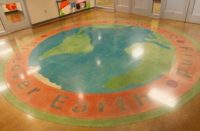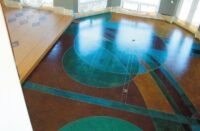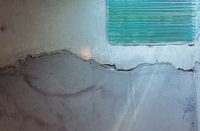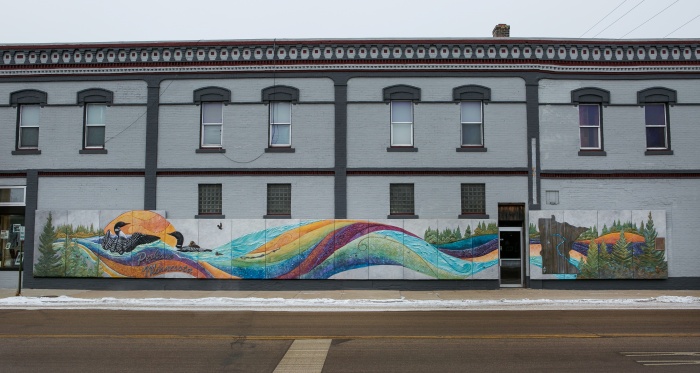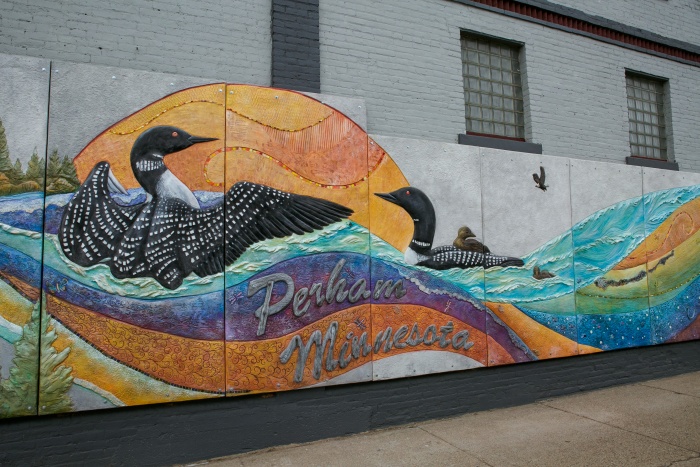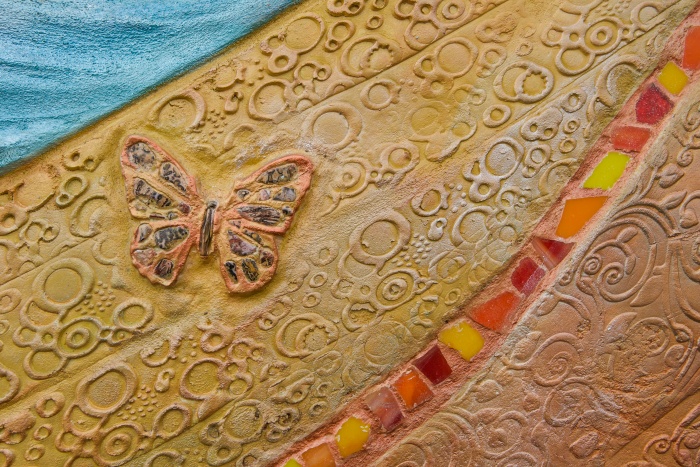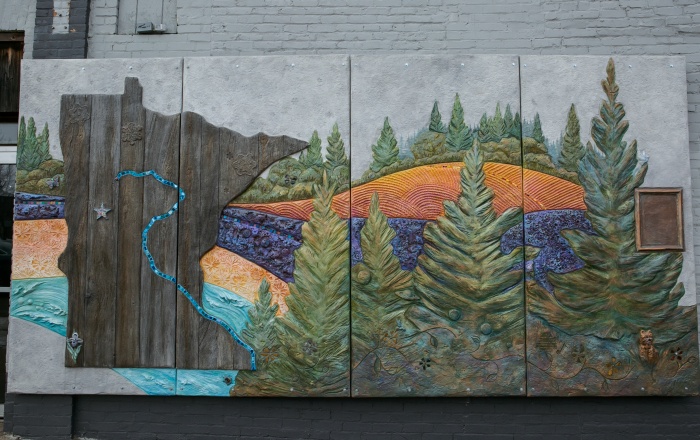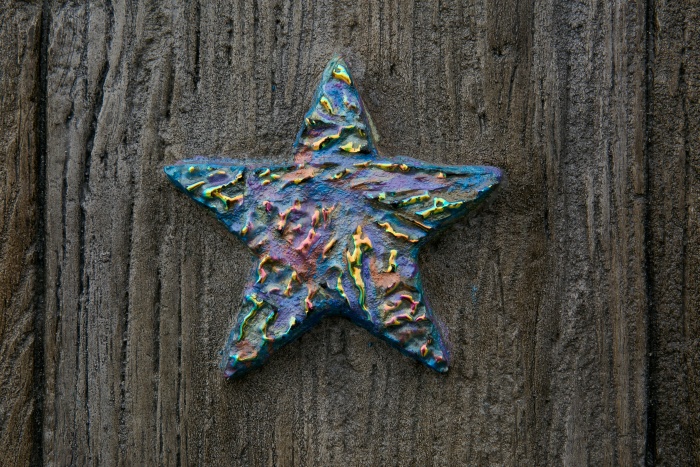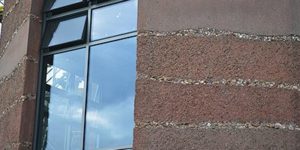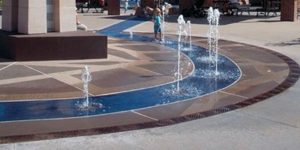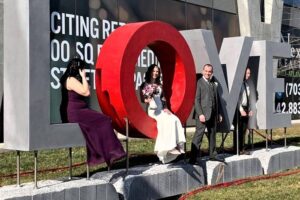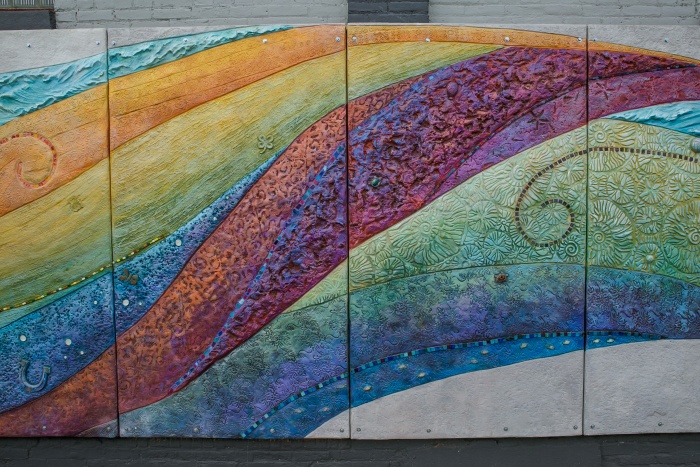
Sisters Cindee Lundin and Chenoa Pickrain were raised on a dairy farm near Perham, Minnesota. Lundin is an expert in faux finishing and horizontal and vertical carved concrete. Pickrain is a graphic designer and photographer. Together, they brainstormed how to improve the drab brick facade of a historic building in their hometown. Thanks to their talents, a 70-foot-long carved concrete mural now greets visitors to the town.
Lundin studied fine art in college, and developed a successful faux-finishing and decorative concrete business in Perham before relocating to Arizona. The city of Perham approached Lundin about creating a mural on the exterior of the historic building.
“They knew I was an artist and they asked me what I could do on this building,” Lundin says. “It was such an honor being approached by a town that is really dear to your heart. This whole piece was inspired by our love for the Minnesota lakes and by growing up in the heart of it. I hope that as people explore Perham, Minnesota, they will take the time to enjoy the colors and the textures that surround them.”
Mural on panels
The mural resides on the outside wall of what was the first solid brick building in Perham, built in 1887 using brick from the Perham brickyard. Because of the old brick, the building’s facade was soft and crumbly. “I knew I couldn’t do anything directly on this building,” she says. “So we created panels that I could work on in my studio.”
The design was created on 18 weatherproof panels, each 4 feet wide and either 7 or 8 feet tall. Lundin uses EZChem Inc. products exclusively — she covered the panels with a scratch coat of Texture Blend 2K, followed then by a thicker coat of the company’s Vertical Stamp Mix for the carving layer.
Pickrain used her graphic design skills to create a computerized sketch of each panel. Once the background texture was applied, the computerized image was projected onto the panels. Using that as a guide, Lundin carved using hand tools and created textures on the stamp mix using forks, roller stamps, brushes and other found items. “Each panel took from two to four days of carving before it was ready to color,” Lundin says.
A large loon, trees and vibrant bands of color are highlighted with metallic UV-stable colors. Enviro Seal mixed with metallics followed by a UV-protective urethane was used as a top coat. The backs of the panels were sealed with an additional waterproofing coat of epoxy. Once the panels were completed, each was protectively wrapped and shipped 1,900 miles to Minnesota. The mural was dedicated to the community Dec. 22, 2014.
Discover the details
Numerous detail objects were added, including fused-glass elements such as wings of dragonflies and turtle shells. Fifty hidden objects related to the town’s history and natural environment are carved into the concrete for people to seek and find. Lundin hopes these objects, “spark a conversation, a memory or an emotion,” about Perham. A flier listing the objects, their whereabouts and their meaning is available at the Perham Chamber headquarters.
“I was sent a picture of someone bringing their grandson to look at the mural and find the hidden objects,” she says. “I was so pleased with this photo because it is doing exactly what I was hoping. It is creating a reason to go outside, enjoy art and encourage communication among its viewers! I had another person call me to tell me that they took their whole family to look and find the different carved details. This just thrilled me!”
Hooked on concrete
The mural was funded by more than $45,000 in donations from local businesses and individuals. This spring, Lundin returned to Perham to install an overlay in front of the mural that resembled a river running over the sidewalk. Lundin also created a faux-bois bench that sits in front of the mural. The second phase of work was completed in time for Perham’s annual summer Turtle Fest that celebrates the turtles living in the more than 1,000 lakes surrounding the city.
Lundin created her art using paint and plaster before her husband, Mark, told her she needed to add decorative concrete to her repertoire. At first, she resisted. “Mark and I worked together for several years and he wanted to add decorative concrete but I felt we had so much work already doing murals, plasters and furniture I didn’t feel we could add another element,” Lundin says.
“But he really thought we should add decorative concrete and was adamant about it. That’s when he went to learn and came back and shared it with me. I was hooked from day one. Concrete is my favorite medium now. It’s what I do for a living, full-time.”
